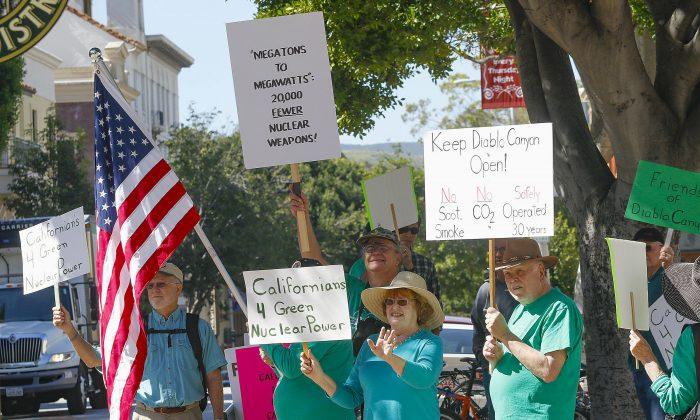Thorium energy experts at the Thorium Energy Alliance Conference told The Epoch Times what they believe has limited the use of the mildly radioactive element, long touted as a potential alternative or complement to plutonium and enriched uranium in nuclear reactors.
Unlike uranium-235, the isotope in enriched uranium that sustains a nuclear chain reaction, thorium is fertile, not fissile. It must be bombarded with neutrons to produce a fissile isotope, uranium-233.
“We don’t have a practical way in this country to use thorium profitably in reactors that exist,” Mark Nelson, managing director of the consultancy Radiant Energy Group, said in an Oct. 13 interview with The Epoch Times. “We are unlikely to have it in the next 10 years unless we find a way to start licensing and building heavy-water reactors in this country, like Canada’s CANDU [Canadian Deuterium Uranium].”
Nelson was at the Oct. 13–14 conference to speak on behalf of Clean Core, a Chicago-based nuclear energy firm.
Clean Core has collaborated with Texas A&M University, the Department of Energy, and the Idaho National Laboratory to develop a new thorium- and uranium-based fuel that is suited to a well-established type of heavy-water CANDU reactor.

The CANDU is quite distinct from molten salt reactors—another design that some thorium energy advocates have championed.
He wanted to ensure the United States’ nuclear industry could remain viable over the long run.
“There is enough thorium to power the world for about 10,000 years and ... [thorium molten salt] reactors would breed more fuel than what they started with,” Jim Kennedy of Caldera Holdings wrote in an April 26 email to The Epoch Times.
He was another speaker at the Thorium conference.

He believes the light-water reactor industry helped smother thorium molten salt reactors in the cradle.
He argued that the challenges of developing corrosion-resistant materials and handling reactor waste make the platform a dead end.
For its part, China is rapidly moving ahead with what it claims is an experimental thorium molten salt reactor, along with scores of other experimental and commercial reactors.
Meanwhile, the United States’ nuclear fleet is in freefall, declining to just 93 at the end of 2021 from a peak of 104 reactors in 2012. Michigan’s Entergy shut down another plant earlier this year, bringing down the total number of functioning reactors in the country to just 92.
On the other hand, the nation’s first new nuclear unit in decades, Vogtle 3 in Georgia, started loading fuel on Oct. 14.
“The Chinese can afford to experiment because they have a large number of outstanding experts. We have let our nuclear building capacity rot, and we are having to rebuild it,” Nelson said.
Like Kennedy, another thorium entrepreneur at the conference, Ed McGinnis, noted the early focus on molten salt reactors by the developers of nuclear energy, particularly Oak Ridge National Laboratory’s Alvin Weinberg.

McGinnis spoke with The Epoch Times in an Oct. 13 interview.
Now the CEO of Curio, a new nuclear technology company and a major sponsor of the conference, McGinnis spent decades working on nuclear weapons and nuclear energy for the federal government. That included a stint as executive director of the President’s Council of Advisers on Science and Technology under then-President Donald Trump.
He said that by the time he entered the nuclear world, “the trajectory was set to stay with the uranium fuel cycle and pressurized water reactors.”
Funds for nuclear research and development hit a trough during the late 1990s and early 2000s. At that point, McGinnis’s colleagues in the Department of Energy faced what he called a “difficult if not Machiavellian decision.”
“I think there was great recognition of the thorium fuel cycle potential, but they were dealing with extremely limited funds.”
In a zero-sum competition between uranium and thorium, the incumbent won.
“We never really got the resource infusion to really test the ability to go beyond just uranium,” he said.
The federal government is an inescapable presence in the nuclear industry, given the regulatory burden on the industry and the specific national security concerns attendant on the technology.
Startups often need access to federal facilities for early research and development, and public–private partnerships such as Clean Core’s aren’t uncommon.
McGinnis thinks thorium’s potential can and should be addressed through the market, albeit not without some broadly dispersed federal funding, based on an “all-of-the-above” approach to the country’s energy future.
Nuclear Power Gaining Ground
Nelson, McGinnis, and Kennedy were among many nuclear power experts who spoke at the conference, held at Albuquerque’s National Museum of Nuclear Science and History.Surrounded by the Cold War-era weapons on display at the museum, one can easily overlook the peaceful uses of nuclear reactions. (The museum has no shortage of exhibits on nuclear power, including thorium—they’re just physically or narratively dwarfed by relics such as the Special Atomic Demolition Munition (SADM), a warhead in a backpack that would have been used to thwart the advance of the Soviet military.)
Amid rising fossil fuel prices, a push for decarbonization, and growing awareness of wind and solar shortcomings, concerns about the weaponization of nuclear energy have ebbed. And since thorium isn’t fissile, it’s relatively invulnerable to proliferation.

Many environmentalists have historically opposed nuclear energy, citing concerns over the disposal of nuclear waste and meltdowns.
Yet, with the rise of the pro-nuclear “eco-modernist” movement, led by figures such as Michael Shellenberger, the energy on nuclear energy may be shifting.
Karl Alex Pauls, a software engineer and environmentalist, told the conference how he'd convinced more and more left-wing, anti-nuclear eco-warriors to back atom splitting.
“The Democratic Party has changed,” he said, drawing applause from the crowd.
One survey by EcoAmerica, shared during the conference, told a remarkable story about the partisan politics of nuclear power.
The survey found that about 64 percent of Republicans have steadily supported the energy source since 2018. Yet, support among Democrats rose to 60 percent in 2021 from just 37 percent in 2018. National support rose to 59 percent from 49 percent over the same period.
That change in public opinion may help explain why 2021’s bipartisan Infrastructure Investment and Jobs Act included a $6 billion program to keep nuclear plants afloat even as they lose money.

Radiant’s Nelson also believes there’s an emerging bipartisan consensus in favor of nuclear power. Both he and McGinnis said greater consistency on nuclear policy between presidential administrations would help maintain that momentum.
“What’s not clear is a plan to make a nuclear energy program,” he said.
Curio’s McGinnis wants to boost public support by providing an answer to nuclear waste; his company has introduced a nuclear recycling process called NuCycle, motivated in part by the federal government’s inaction on nuclear waste storage in Nevada’s Yucca Mountain.
“If the single biggest reason why many oppose nuclear, even beyond health, is waste, and we’re dead in the water on Yucca, recycling is a no-brainer. The other leading countries—Russia, China, France, even Japan—they recycle, or they’re in the process, because it makes sense,” he said.

Even still, many environmentalists oppose nuclear energy for a deeper reason: They see it as contrary to the aim of “degrowth.”
Nelson thinks the downstream effects of the Russia–Ukraine war, which has disrupted global energy markets, will test the strength of those convictions.
“My personal view is that those degrowthers will become a much rarer species after the upcoming two brutal winters that are locked in at this point for Europe, the home of degrowth ideology,” he said.
In his opening remarks, John Kutsch, founder and executive director of the Thorium Energy Alliance, highlighted another challenge to accelerating and expanding the use of thorium—“what people call consensus building these days,” citing the challenges involved in changing an American Nuclear Society definition that informs key regulation by the Nuclear Regulatory Commission.
‘Teslafication’ and Nuclear Moonshot
Thorium experts at the conference said the U.S. nuclear industry could benefit from being innovation-oriented toward real growth—what McGinnis described as “Tesla-fying” nuclear, in line with practices that Elon Musk has used to develop successful companies.
Nelson suggested the advanced nuclear sector has been hampered at times by a focus on innovation for its own sake.
“If nuclear reactors exist and work really well, then a redesign may offer very little,” he said.
Caldera’s Kennedy has argued that “economies of standardization were purposely never attempted in the USA.”
“The nuclear market has become substantially ossified and not in a growth posture, and it needs new, innovative blood,” McGinnis said.
Nelson thinks the finance industry’s focus on decarbonization could lead to more money and, down the line, better management practices in the nuclear industry.
Yet, he stressed an even more fundamental choice facing Americans:
“I think the nation needs to decide that having a large share of its electricity coming from nuclear is a priority.”
“We need a program where a national goal, like going to the moon, is getting lots of cheap nuclear plants—and we accept that it will be a lot of money and a lot of years to achieve, by the end of the program, not much money per reactor and not many years per reactor.”






